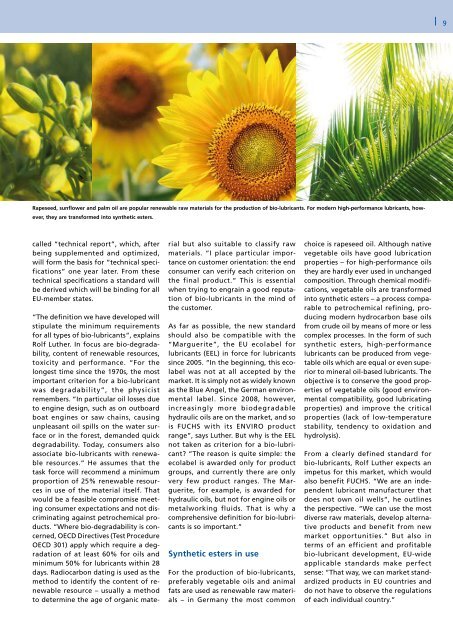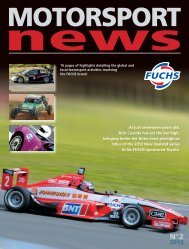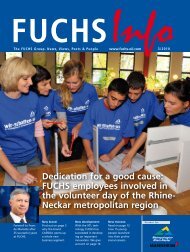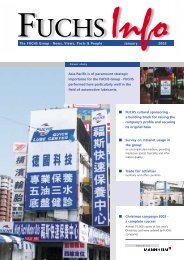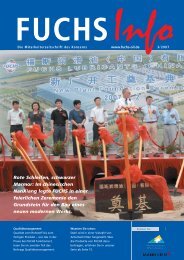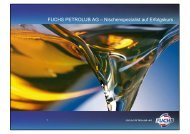Happy shareholders at the FUCHS annual ... - fuchs petrolub ag
Happy shareholders at the FUCHS annual ... - fuchs petrolub ag
Happy shareholders at the FUCHS annual ... - fuchs petrolub ag
You also want an ePaper? Increase the reach of your titles
YUMPU automatically turns print PDFs into web optimized ePapers that Google loves.
Rapeseed, sunflower and palm oil are popular renewable raw m<strong>at</strong>erials for <strong>the</strong> production of bio-lubricants. For modern high-performance lubricants, however,<br />
<strong>the</strong>y are transformed into syn<strong>the</strong>tic esters.<br />
called “technical report”, which, after<br />
being supplemented and optimized,<br />
will form <strong>the</strong> basis for “technical specific<strong>at</strong>ions”<br />
one year l<strong>at</strong>er. From <strong>the</strong>se<br />
technical specifi c<strong>at</strong>ions a standard will<br />
be derived which will be binding for all<br />
EU-member st<strong>at</strong>es.<br />
“The definition we have developed will<br />
stipul<strong>at</strong>e <strong>the</strong> minimum requirements<br />
for all types of bio-lubricants“, explains<br />
Rolf Lu<strong>the</strong>r. In focus are bio-degradability,<br />
content of renewable resources,<br />
toxicity and performance. “For <strong>the</strong><br />
longest time since <strong>the</strong> 1970s, <strong>the</strong> most<br />
important criterion for a bio-lubricant<br />
was degradability”, <strong>the</strong> physicist<br />
remembers. “In particular oil losses due<br />
to engine design, such as on outboard<br />
bo<strong>at</strong> engines or saw chains, causing<br />
unpleasant oil spills on <strong>the</strong> w<strong>at</strong>er surface<br />
or in <strong>the</strong> forest, de manded quick<br />
degradability. Today, consumers also<br />
associ<strong>at</strong>e bio-lubricants with renewable<br />
resources.“ He assumes th<strong>at</strong> <strong>the</strong><br />
task force will recommend a minimum<br />
proportion of 25% renewable resources<br />
in use of <strong>the</strong> m<strong>at</strong>erial itself. Th<strong>at</strong><br />
would be a feasible compromise meeting<br />
consumer expect<strong>at</strong>ions and not discrimin<strong>at</strong>ing<br />
<strong>ag</strong>ainst petrochemical products.<br />
“Where bio-degradability is concerned,<br />
OECD Directives (Test Pro cedure<br />
OECD 301) apply which require a degrad<strong>at</strong>ion<br />
of <strong>at</strong> least 60% for oils and<br />
minimum 50% for lubricants within 28<br />
days. Radiocarbon d<strong>at</strong>ing is used as <strong>the</strong><br />
method to identify <strong>the</strong> content of re -<br />
newable resource – usually a method<br />
to determine <strong>the</strong> <strong>ag</strong>e of organic m<strong>at</strong>e-<br />
rial but also suitable to classify raw<br />
m<strong>at</strong>erials. “I place particular importance<br />
on customer orient<strong>at</strong>ion: <strong>the</strong> end<br />
consumer can verify each criterion on<br />
<strong>the</strong> final product.“ This is essential<br />
when trying to engrain a good reput<strong>at</strong>ion<br />
of bio-lubricants in <strong>the</strong> mind of<br />
<strong>the</strong> customer.<br />
As far as possible, <strong>the</strong> new standard<br />
should also be comp<strong>at</strong>ible with <strong>the</strong><br />
“Marguerite”, <strong>the</strong> EU ecolabel for<br />
lubricants (EEL) in force for lubricants<br />
since 2005. “In <strong>the</strong> beginning, this ecolabel<br />
was not <strong>at</strong> all accepted by <strong>the</strong><br />
market. It is simply not as widely known<br />
as <strong>the</strong> Blue Angel, <strong>the</strong> German environmental<br />
label. Since 2008, however,<br />
increasingly more biodegradable<br />
hydraulic oils are on <strong>the</strong> market, and so<br />
is <strong>FUCHS</strong> with its ENVIRO product<br />
range”, says Lu<strong>the</strong>r. But why is <strong>the</strong> EEL<br />
not taken as criterion for a bio-lubricant?<br />
“The reason is quite simple: <strong>the</strong><br />
ecolabel is awarded only for product<br />
groups, and currently <strong>the</strong>re are only<br />
very few product ranges. The Marguerite,<br />
for example, is awarded for<br />
hydraulic oils, but not for engine oils or<br />
metalworking fluids. Th<strong>at</strong> is why a<br />
comprehensive definition for bio-lubricants<br />
is so important.”<br />
Syn<strong>the</strong>tic esters in use<br />
For <strong>the</strong> production of bio-lubricants,<br />
preferably vegetable oils and animal<br />
f<strong>at</strong>s are used as renewable raw m<strong>at</strong>erials<br />
– in Germany <strong>the</strong> most common<br />
choice is rapeseed oil. Although n<strong>at</strong>ive<br />
vegetable oils have good lubric<strong>at</strong>ion<br />
properties – for high-performance oils<br />
<strong>the</strong>y are hardly ever used in unchanged<br />
composition. Through chemical modific<strong>at</strong>ions,<br />
vegetable oils are transformed<br />
into syn<strong>the</strong>tic esters – a process comparable<br />
to petrochemical refining, producing<br />
modern hydrocarbon base oils<br />
from crude oil by means of more or less<br />
complex processes. In <strong>the</strong> form of such<br />
syn<strong>the</strong>tic esters, high-performance<br />
lubricants can be produced from vegetable<br />
oils which are equal or even superior<br />
to mineral oil-based lubricants. The<br />
objective is to conserve <strong>the</strong> good properties<br />
of vegetable oils (good environmental<br />
comp<strong>at</strong>ibility, good lubric<strong>at</strong>ing<br />
properties) and improve <strong>the</strong> critical<br />
properties (lack of low-temper<strong>at</strong>ure<br />
stability, tendency to oxid<strong>at</strong>ion and<br />
hydrolysis).<br />
From a clearly defined standard for<br />
bio-lubricants, Rolf Lu<strong>the</strong>r expects an<br />
impetus for this market, which would<br />
also benefit <strong>FUCHS</strong>. “We are an independent<br />
lubricant manufacturer th<strong>at</strong><br />
does not own oil wells“, he outlines<br />
<strong>the</strong> perspective. “We can use <strong>the</strong> most<br />
diverse raw m<strong>at</strong>erials, develop altern<strong>at</strong>ive<br />
products and benefit from new<br />
market opportunities.” But also in<br />
terms of an efficient and profitable<br />
bio-lubricant development, EU-wide<br />
applicable standards make perfect<br />
sense: “Th<strong>at</strong> way, we can market standardized<br />
products in EU countries and<br />
do not have to observe <strong>the</strong> regul<strong>at</strong>ions<br />
of each individual country.”<br />
9


